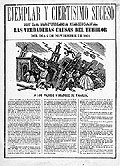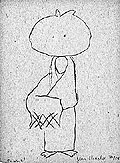By Virginia Wageman
Advertiser Art Critic
A social chronicler of the events of his day, Jose Guadalupe Posada (1852-1913) documented in engravings and etchings the sensational news stories of turn-of-the-century Mexico. The prints, collected and given to the University of Hawai‘i by Jean Charlot, are exhibited together for the first time in an exhibition at the university’s Art Gallery.
 |
| José Guadalupe Posada, “Ejemplar y Ciertísimo Suceso en la República Mexicana” (Cautionary and Most Certain Event in the Mexican Republic), engraved broadside. Jean Charlot Collection, University of Hawai‘i Library Collection.
Brad Goda |
Posada, a printer and engraver, set up shop in Mexico City in the early 1890s, offering his services as an illustrator and lithographer. Beginning first with woodcuts, he later made etchings with zinc plates. He worked for at least 24 newspapers, including Vanegas Arroyo Publishing House, which published his prints from 1890 until his death.
Virtually anonymous, Posada was all but forgotten until French artist Jean Charlot discovered his prints and blocks at Vanegas Arroyo on a 1921-22 visit to Mexico and began collecting them. Then in 1925, Charlot wrote an article on Posada for a Mexican journal.
Other artists soon became aware of Posada, including the Russian filmmaker Sergei Eisenstein, who paid tribute to him in a 1929 film, and Diego Rivera, who included a portrait of Posada in a mural on Mexican history. French surrealist AndrÚ Breton was drawn to Posada’s prints as exemplars of black humor, and by 1944 the Art Institute of Chicago had held a Posada retrospective.
In 1982, Charlot’s collection of 500 Posada prints was given to Hamilton Library at UH. On display are 250 of these prints, selected by Nancy Morris, curator of the university’s Charlot collection, and Tom Klobe, director of the Art Gallery. The prints are in the form of broadsides, sheets of paper with printed news stories or editorials, each accompanied by a Posada etching. These were hawked on the street, much as modern newspapers might be.
The publications were the equivalent of today’s "National Enquirer," read by the masses for their sensational stories. They told of bloody bullfights, horrid tortures and grisly murders, and their morals warned that sinners would be engulfed in the flames of hell.
|
Jose Guadalupe Posada
 Art Gallery, University of Hawai‘i at Manoa. Through April 6. 956-6888 Art Gallery, University of Hawai‘i at Manoa. Through April 6. 956-6888
 Jean Charlot: A Mexican Journey Commons Gallery, Art Dept., University of Hawai‘i at Manoa. Through March 16. Jean Charlot: A Mexican Journey Commons Gallery, Art Dept., University of Hawai‘i at Manoa. Through March 16.
 956-6888 956-6888
|
Many of the illustrations are for stories about natural disasters such as torrential floods and devastating earthquakes, as in a spectacular illustration of the 1894 Mexico City quake. Others have to do with the struggles of love and marriage. They also chronicled and satirized political and social events.
In "El Mosquito Americano," American capitalists who exploited Mexican workers are depicted as mosquitoes attacking Mexico’s middle class, the people who owned the factories and who welcomed American capital. Like the 1894 earthquake engraving, "El Mosquito" demonstrates Posada’s skilled compositional techniques and vivid depictions of action, with giant buzzing mosquitoes aiming in the same directions as the fleeing legs of the fashionably dressed men and women.
Many are printed poorly, as to be expected of penny sheets, and they are on cheap paper that has yellowed over the years. The aged sheets have little of the immediacy and vivacity they would have had when new.
To counterbalance this sense of the old and fading, the gallery’s walls and divider panels are painted in vivid, saturated colors that evoke a gaily painted Mexican village. Angling in various directions, the panels suggest the leaning walls of peasant shacks. Wall labels provide context for the broadsides, though they are written as if in Posada’s voice, a clever conceit but one that eschews contemporary interpretation.
The brilliant exhibition design would be even better were there
didactic panels providing more information about Mexico’s social, historical and artistic history, perhaps with photographs of some of Posada’s subjects.
 |
| Jean Charlot, “Lavandera,” 1923, lithograph. Jean Charlot Collection, University of Hawai‘i Library.
Brad Goda |
In conjunction with the Posada exhibition, students in Klobe’s museum studies class have put together a small but choice exhibition of drawings and prints made by Jean Charlot during visits to Mexico in the 1920s.
Charlot’s studies of the common people of Mexico led to his mural "Massacre in the Main Temple" (Mexico City), which is documented here. Charlot was not influenced by Posada’s art as such, but he found in Posada a kindred spirit in their shared interest in Mexico’s working class who lived out their lives on the streets.
Charlot dedicated a book of his drawings, "Dance of Death," published in 1951, to Posada, indicating that the drawings were in homage to the older artist. Unfortunately, none of these illustrations are included in the show. Several books are available for perusing in the exhibition, though not this one.
The students have nonetheless done an excellent job in their selection of works from Charlot’s Mexican sojourns, with additional photographic material that provides a social and artistic context.
Virginia Wageman can be reached at VWageman@aol.com
[back to top] |

 The Great Index to Fun
The Great Index to Fun
